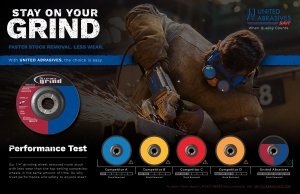Competitor Test: What Makes a Grinding Wheel Outperform Another?
Many different companies boast about the performance of their grinding wheels, but often can’t back it up. Of course, as a consumer, it’s hard to know which wheels you should trust.
We believe that you deserve to know what really makes one grinding wheel outperform another. Keep reading to learn more about how the grain and bonding agents used in abrasives manufacturing affects their performance, then view the results of a competitor test we did ourselves.
The Grain
Grinding wheels are generally made up of two different major components — the grains that actually do the cutting, and a bonding agent that holds these grains together and provides support while they cut.
Most grinding wheels are made out of an aluminum oxide grain, but where brands differ is in the usage of filler grains as opposed to uniform — uniform allows for a better cut and also tends to last longer. Wheels with filler grains are more susceptible to cracking or leaving an uneven finish on your job.
The Bond
The bond that holds the abrasive grains together in a wheel allows the tool to either cut properly… or let you down and give out halfway through a job.
Grinding wheel bonds can either be classified as “hard” or “soft.” You choice of bond should directly relate to the type of job you’re doing. A wheel with a hard bond is is used on high-horsepower machines and on small or narrow surfaces. Here is an example of one of our hard bonded wheels. Soft bonded wheels are used on jobs that require rapid stock removal, and on hard materials or large areas of contact. Click here to take a look at a soft bonded wheel.
A hard bond will resist the separation of grains, causing it to wear down more slowly, while a soft bond won’t last as long and will need more frequent replacements. The quality of the bond has a huge impact on the wheel performance, however. Too hard and the wheel won’t last and shatter; too soft and the wheel will wear down after limited cuts.
The Test
Now that you know what determines grinding wheel performance, we wanted to see how our ¼” grinding wheel, which features a soft bond and uniform grain, stacks up against four of our competitors’ similar wheels.
The results speak for themselves:

Our grinding wheel lasted longer and removed more stock quicker, all with less wear. Better bonding agents, a uniform grade — all of it combines to give you the performance you deserve.
Click here: Learn more about how our new website makes it easy to find the right abrasives for any job.
![]() Are you looking for grinding wheel offered in a specific diameter or a grinding wheel for a specific application? Check out our metal grinding wheels, aluminum grinding wheels, or 4.5″ grinding wheels.
Are you looking for grinding wheel offered in a specific diameter or a grinding wheel for a specific application? Check out our metal grinding wheels, aluminum grinding wheels, or 4.5″ grinding wheels.
Subscribe
Get product news and tips straight to your inbox